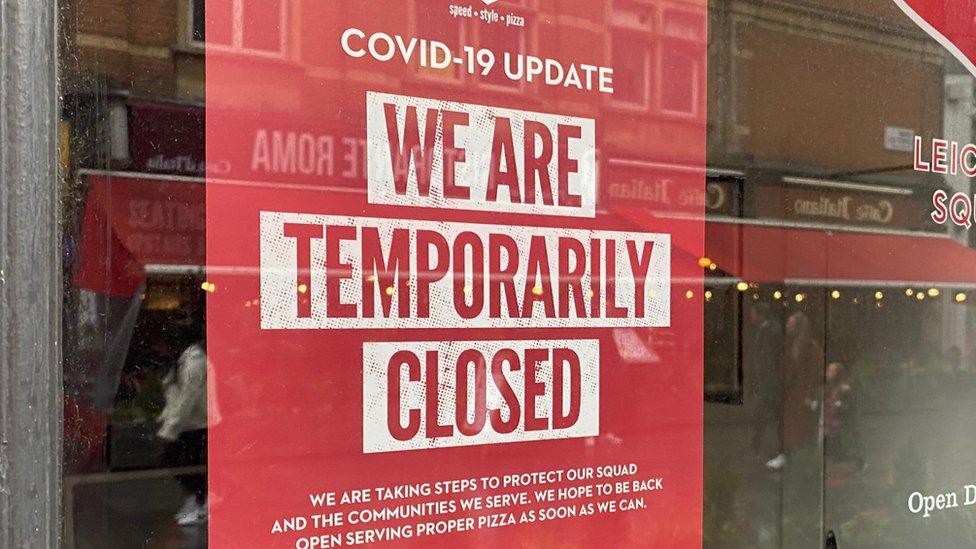Covid: Was it right to extend the furlough scheme?
- Published

As soon as government decided to announce another lockdown in England, it was clear it would need to do something significant to protect jobs. The question was - what?
With many businesses forced to close, and others facing reduced income, there was a risk of rapidly rising unemployment.
The furlough scheme, which had helped to keep unemployment from rocketing during the first lockdown in the spring, was due to end on the very day the new lockdown was announced, 31 October.
The government at first declared a one-month extension - then on 5 November, the Chancellor Rishi Sunak announced that it would be extended to a full five months, external.
As before, under the scheme, employees stop doing their jobs and the government pays 80% of their wages.
The Chancellor also increased the generosity of support for self-employed workers, to 80% of three months' average profits up to a total of £7,500.
Why did he do it, and was it the right thing to do?
Extending the furlough scheme
A blanket, nationwide furlough was the simplest option. A blanket furlough scheme covering the whole UK puts an end to the piecemeal negotiations with leaders in different parts of the UK about how much support to give businesses facing more restrictions in their areas.
Extending the original furlough scheme would also be easy to implement and understand. Most businesses and workers will already be familiar with it.
The system which runs the programme was kept operational in case of a second wave, Mr Sunak told the House of Commons.
He also justified the decision to extend the scheme for five months as a necessary measure to give businesses clarity to plan over an economic downturn which could be longer and harsher than previously feared.
Mr Sunak told the House: "As we saw from the first lockdown the economic effects are much longer lasting for businesses and areas than the duration of any restrictions."
"I think it's the right thing to do in the current circumstances," said Carsten Jung, senior economist at the Institute for Public Policy Research think-tank. "The last thing that was announced was only for one month, and that doesn't give enough certainty to businesses to plan ahead."
Chancellor Rishi Sunak has extended the furlough scheme to March
Is furlough just delaying the inevitable?
Furlough is meant to keep staff in their jobs temporarily, until better times return. Keeping links with their employers means they can return to work as soon as conditions improve, without the costs and uncertainty of job hunting, recruitment and training.
But critics argue that many of the jobs being expensively preserved by furlough will never come back.
If many more people work from home instead of commuting into cities, for instance, will the jobs making coffee and sandwiches for them return in the same numbers?
Former Sainsbury's chief executive Justin King said on the World at One on BBC Radio 4 that "we will look back on this time as a good chunk of the money spent on furlough as having been spent … just avoiding the inevitable."
Besides being a waste of money, some argue that keeping workers in these 'zombie' jobs stops them from retraining for new, more productive roles, slowing the eventual recovery. They argue that the money could be better spent supporting the incomes of people who do lose their jobs and helping them retrain.

Many hospitality jobs will still be viable once the pandemic is over
However, many jobs in pubs, restaurants and live entertainment will still be viable once the pandemic is over, said Mr Jung. "We are not expecting the entire hospitality industry to disappear, and those are a lot of the jobs that will be furloughed."
"A lot of the unviable jobs have been shed already," he added.
And it's unlikely a business would keep workers on furlough who they have no prospect of rehiring as they still have to pay national insurance and pension contributions, said Dan Tomlinson, senior economist at the Resolution Foundation. "They still have some skin in the game."
Can we afford to extend the furlough scheme?
One big downside of furlough is the cost - the Resolution Foundation estimates that it could cost around £6bn in the first month, if 5.5 million workers take it up, as the Bank of England predicts.
However, that cost will fall in coming months, as more people return to work when the economy re-opens.
In normal times that would be a huge figure, but not so big in the context of the vast sums spent fighting the coronavirus pandemic.
The government was expected to borrow as much as £391bn this year - more than £1bn a day, according to the Office for Budget Responsibility.
So far there has been little sign that the government is close to the limits on what it can borrow. The rates investors will accept to lend money to the government are still low, despite the big increase in borrowing this year.
As a benchmark, the effective interest rate for lending to the government for ten years is 0.23%, according to Bloomberg. However though the interest rates are low all this extra borrowing is still a burden for future generations to bear.